This post contains affiliate links. Read the full disclosure here.
This biscoff cake has lotus biscoff cookies baked right into each layer, paired with a delicious biscoff buttercream. It's easy to make and has notes of vanilla, brown sugar, and cinnamon! It's every cookie butter lover's dream!

In my opinion, Biscoff spread is truly one of the greatest spreads ever created (yes - even better than peanut butter!). I love using it in brownies, cookies, and cupcakes - it pairs so well with chocolate or vanilla flavors!
This lotus biscoff cake is a truly indulgent dessert. It combines crunchy biscoff cookies, creamy biscoff spread, and a fluffy vanilla layer cake.
If you haven't tried cookie butter yet - oh my goodness words can not describe it!
Why You'll Love This Biscoff Cake
- It's got all the delicious brown sugar and spiced flavors of biscoff and uses both biscoff spread and lotus biscoff cookies.
- The light and fluffy vanilla cake only uses 1 cup of sugar, which means it isn't too sweet and balances out the biscoff buttercream perfectly.
- You can easily adapt the biscoff cake recipe to fit different pan sizes (the instructions are further down in the post).
- Biscoff cookies are layered on the cake for a wonderful texture combination that goes so well with the cake and adds in tons of biscoff flavor!
Ingredient Notes
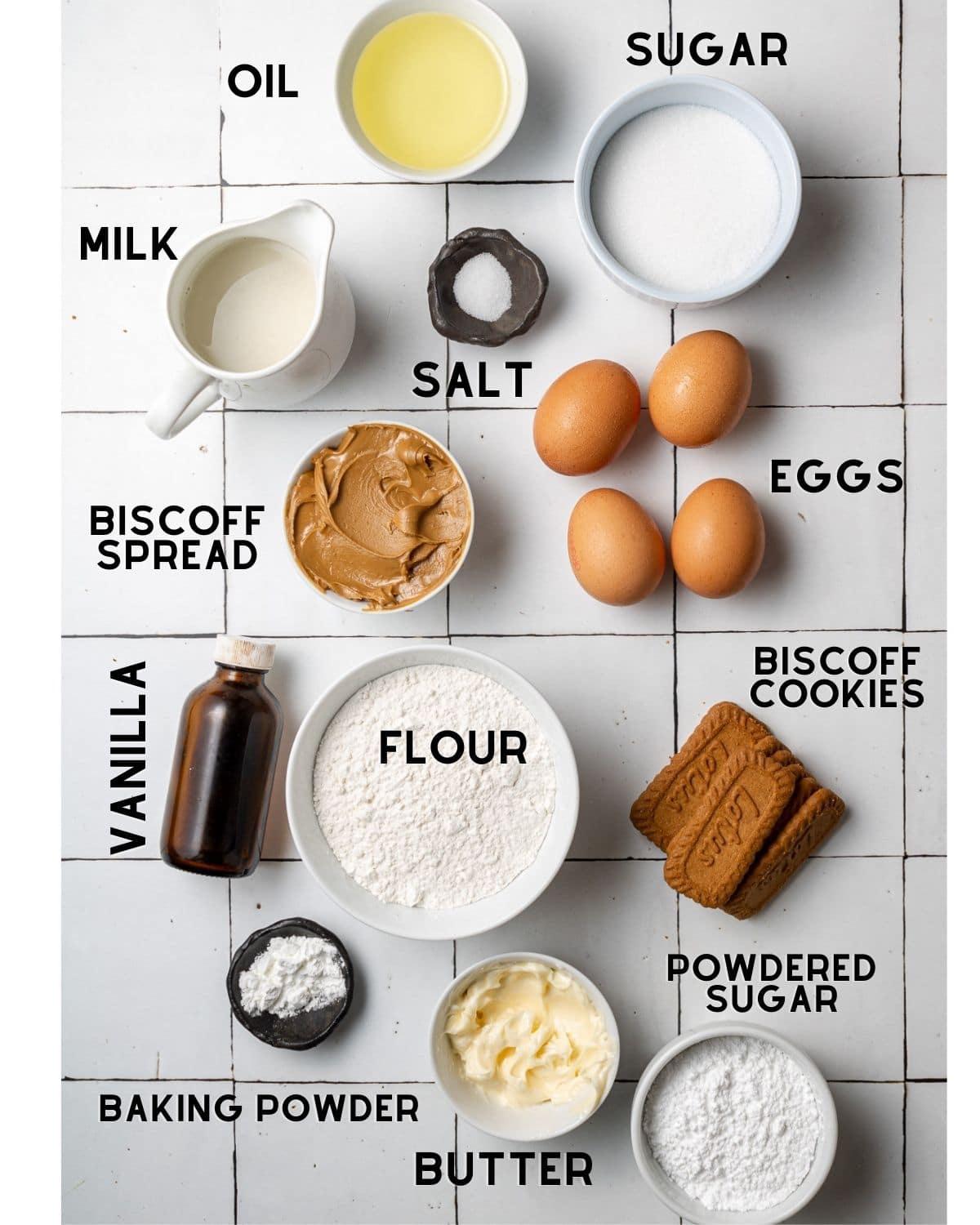
- Milk: You can use regular milk or you can make this biscoff cake dairy free and use your preferred dairy free milk.
- Oil: this cake uses canola oil instead of butter which is key to a fluffy, light crumb. You can also use sunflower oil or other neutral vegetable oil.
- Butter: You can use regular salted butter, or dairy free butter.
- Flour: This recipe uses all-purpose flour, and in order to get a fluffy vanilla cake, I recommend using a kitchen scale to measure your flour. Measuring with a cup can lead to too much flour, which can make the cake dry and dense.
- Biscoff spread (cookie butter): You can use any brand of cookie butter, some places like Trader Joe's or President's Choice make their own brands, and they are all delicious. It can often be found under the name "Speculoos" spread. I recommend the smooth variety but you can also use crunchy!
- Biscoff cookies: You can use any brand of speculoos style cookie, and you can layer both cakes or just add the cookies to one layer - it's up to you!
Step By Step Instructions
Note: Full ingredient measurements and instructions can be found in the recipe card at the bottom of this page.
Step One: Preheat the oven to 350°F. Prepare two 8 inch round cake pans. Spray the inside with cooking spray, then cut round pieces of parchment paper so that they fit in the bottom of each pan. Set the pans aside.
Step Two: In a large bowl, whisk together flour, salt, and baking powder together.
Step Three: In the bowl of a handheld mixer or standing mixer, beat the butter, oil, and sugar together. Mix in the eggs, egg whites, and vanilla extract.
Step Four: Alternate pouring the dry ingredients into the bowl, then pour in the milk. Repeat, mixing between additions and alternating wet and dry until the final specks of flour are gone.
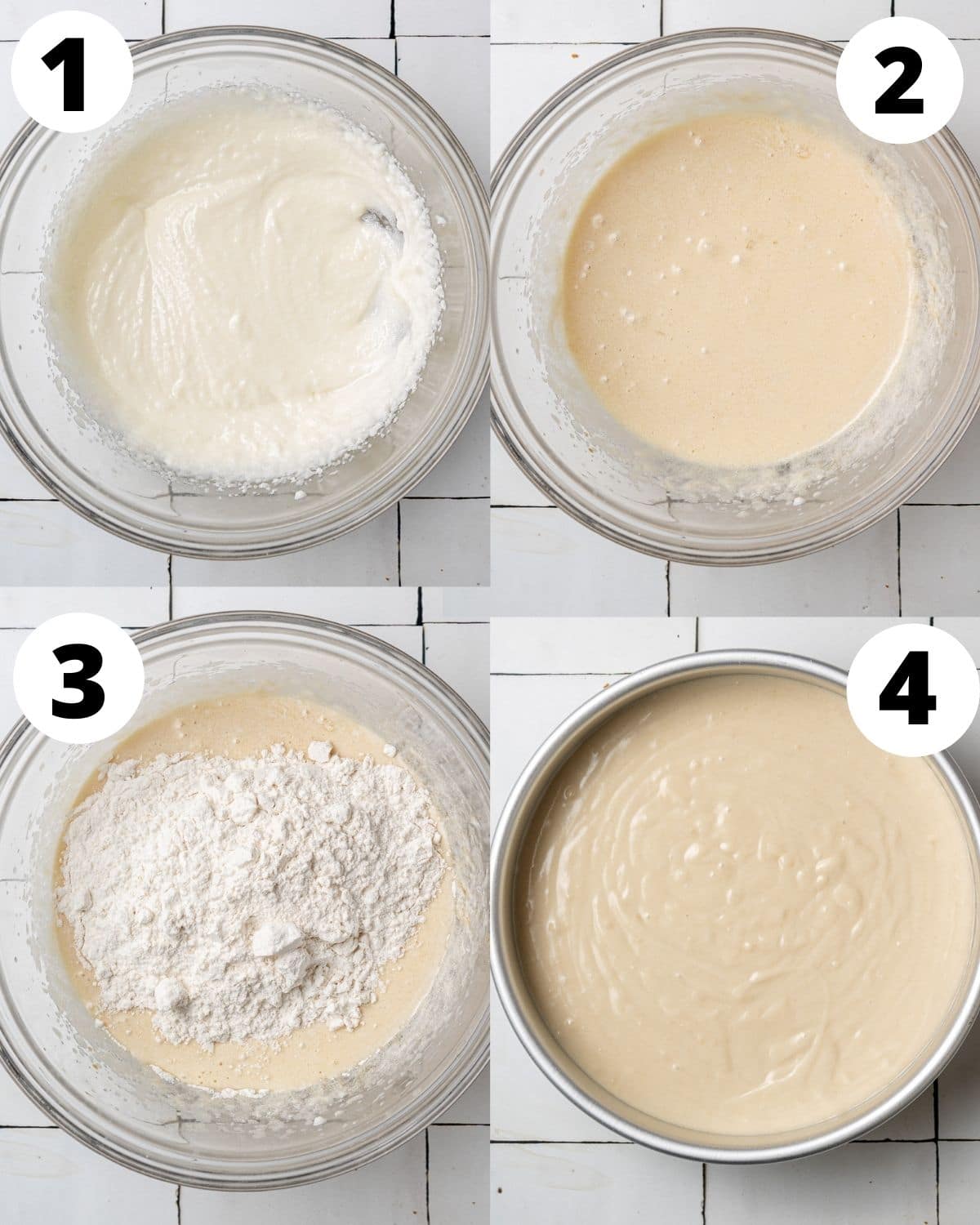
Step Five: Layer biscoff cookies along the bottom of the pan, then pour the batter evenly between the cake pans. *Note that in the video for this post I added cookies on top of the batter. You can do this as well, but if you plan to shave off the top domed part of your cakes before stacking them, it's easier to add the cookies to the pan before the batter.*
Bake for 23-30 minutes, or until a toothpick inserted in the middle of the cakes comes out clean. Let the cakes cool in the pans then remove them from the pans upside down onto a cooling rack.
Step Six: Make the buttercream. In the bowl of a standing mixer or handheld mixer, beat butter and biscoff spread until smooth. Add salt. Slowly add in the powdered sugar, until desired consistency is reached.
Add a little bit of milk to thin out the buttercream if needed.
Step Seven: Once the cakes have cooled, place one of the cakes on a cake plate or stand, with the biscoff cookie side down. You may want to shave the tops of the cake off to get rid of the domes, but that's up to you.
Add a few scoops of buttercream on top and spread it in an even layer, leaving around 1 inch of room around the edges. Place the second cake on top, again with the biscoff cookie side down.
Scoop more buttercream on top of the cake and smooth it out evenly, repeating around the sides of the cake if desired. Melt biscoff and pour it around the edges of the cake, add crushed biscoff cookies on top, and/or pipe more buttercream on top of the cake to decorate the cake to your taste!
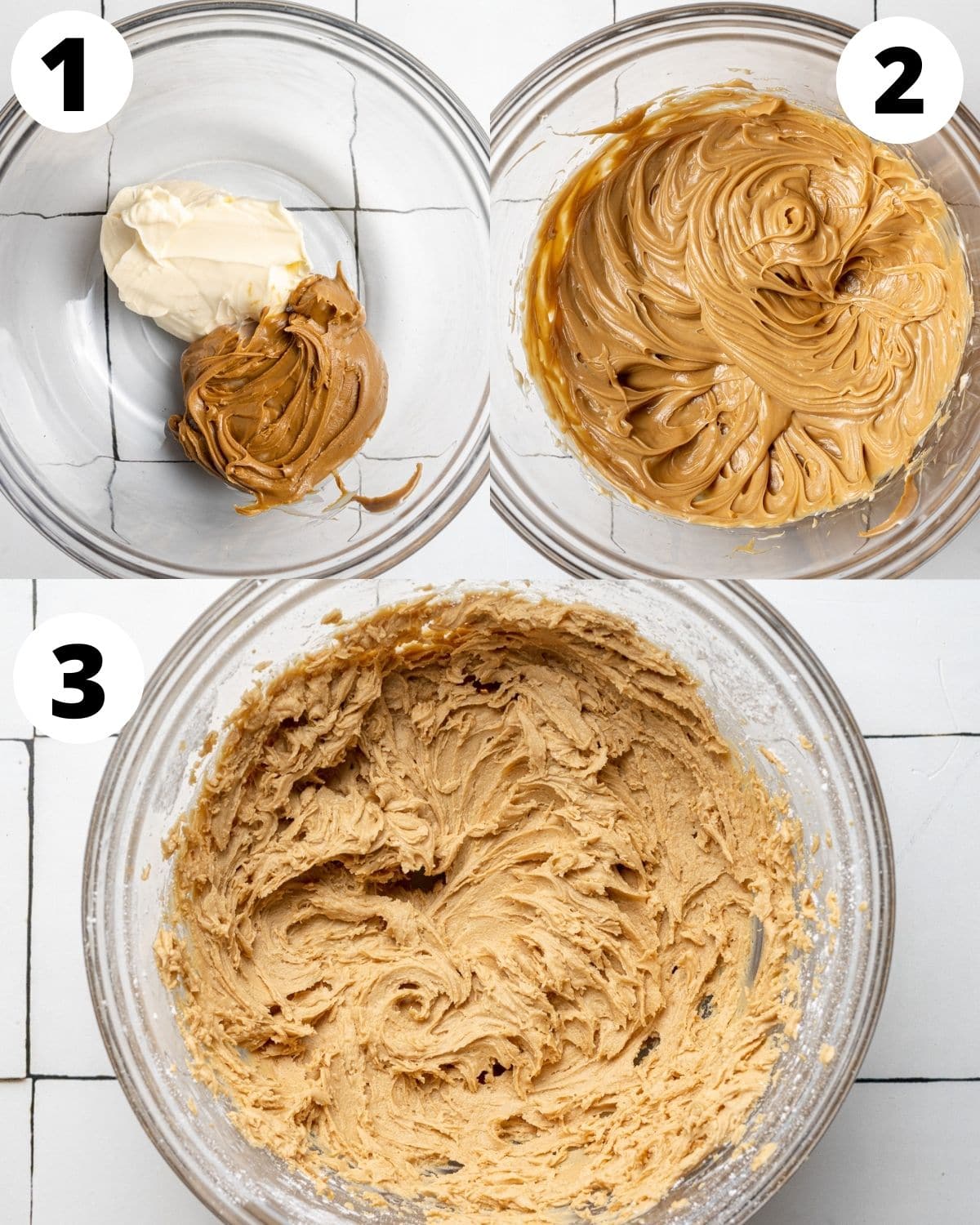
FAQs and Expert Tips
You can buy Biscoff spread on Amazon, and they also sell it at most grocery stores. Some grocery stores even sell it under their own brands, like Walmart, Trader Joe's, or President's Choice.
Biscoff is dairy free, egg free, and vegan, but you should always read the labels as this may vary from one brand to the next, or depending where you live.
I haven't tested this cake without eggs, and they are crucial to the structure of this cake recipe so I don't recommend it.
However, if you have a favorite recipe for a vegan vanilla cake you can use that as the cake base and add the cookie layer and biscoff layer to it!
This cake itself doesn't have biscoff in it. It is a simple vanilla cake recipe, paired with the biscoff cookies and biscoff buttercream.
I tested this cake multiple times with biscoff in the actual cake batter, but it made the cake very dense and sweet!
The options are endless! Here are a few ideas:
1. Melt biscoff cookie butter over the stove or in the microwave and drip it down the top and sides of the cake
2. Pipe frosting on top and stick biscoff cookies into the piped frosting
3. Frost the middle of the cake and the top of the cake only and sprinkle with crushed up biscoff cookies
4. Cover the cake with buttercream, then press biscoff cookies into the side of the cake all the way around
5. Get creative! There are so many fun ways to decorate a biscoff cake!
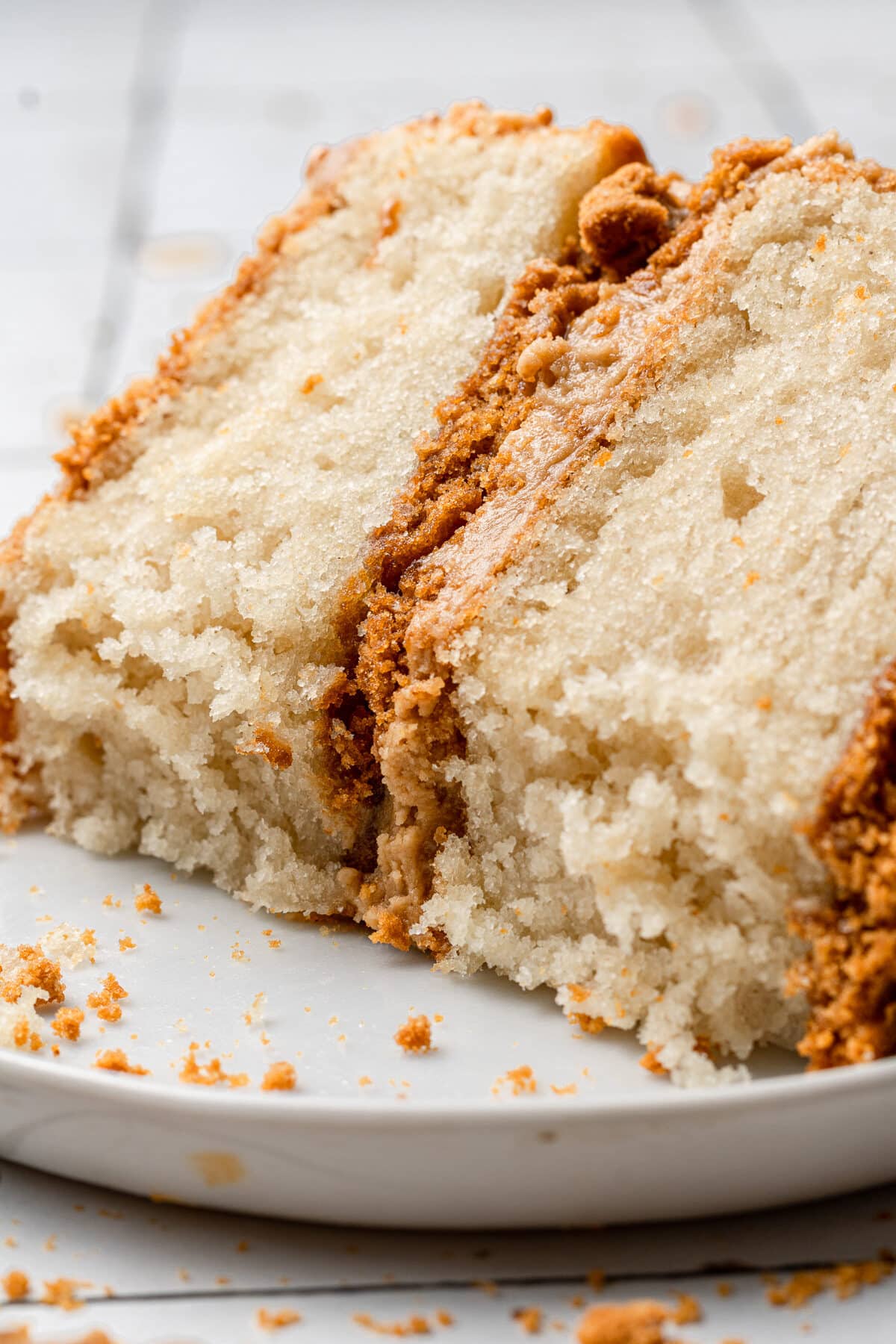
Is this cake very sweet?
Biscoff spread is quite sweet, so this cake recipe was purposely developed to be less sweet.
One way to reduce the sweetness is to assemble this cake with biscoff buttercream in between the cake layers and on top, but not on the sides. When I make this cake for myself I often do that. You won't need as much buttercream if omitting it from the sides.
Can I make this a biscoff chocolate cake?
Sure! The flavors of biscoff go great with chocolate! If you want to use a chocolate cake instead of vanilla, use this chocolate cake recipe (it can be made with regular ingredients if you don't follow a dairy free diet).
Then, simply layer the cookies on top and follow the instructions for the biscoff buttercream.
Can I make this as Biscoff cupcakes?
You're in luck - here is a delicious Biscoff cupcake recipe!
Can I make this cake using different cake pans?
Sure! Instructions for different sizes of cake pans can be found in the Notes section of the recipe card at the bottom of this page.
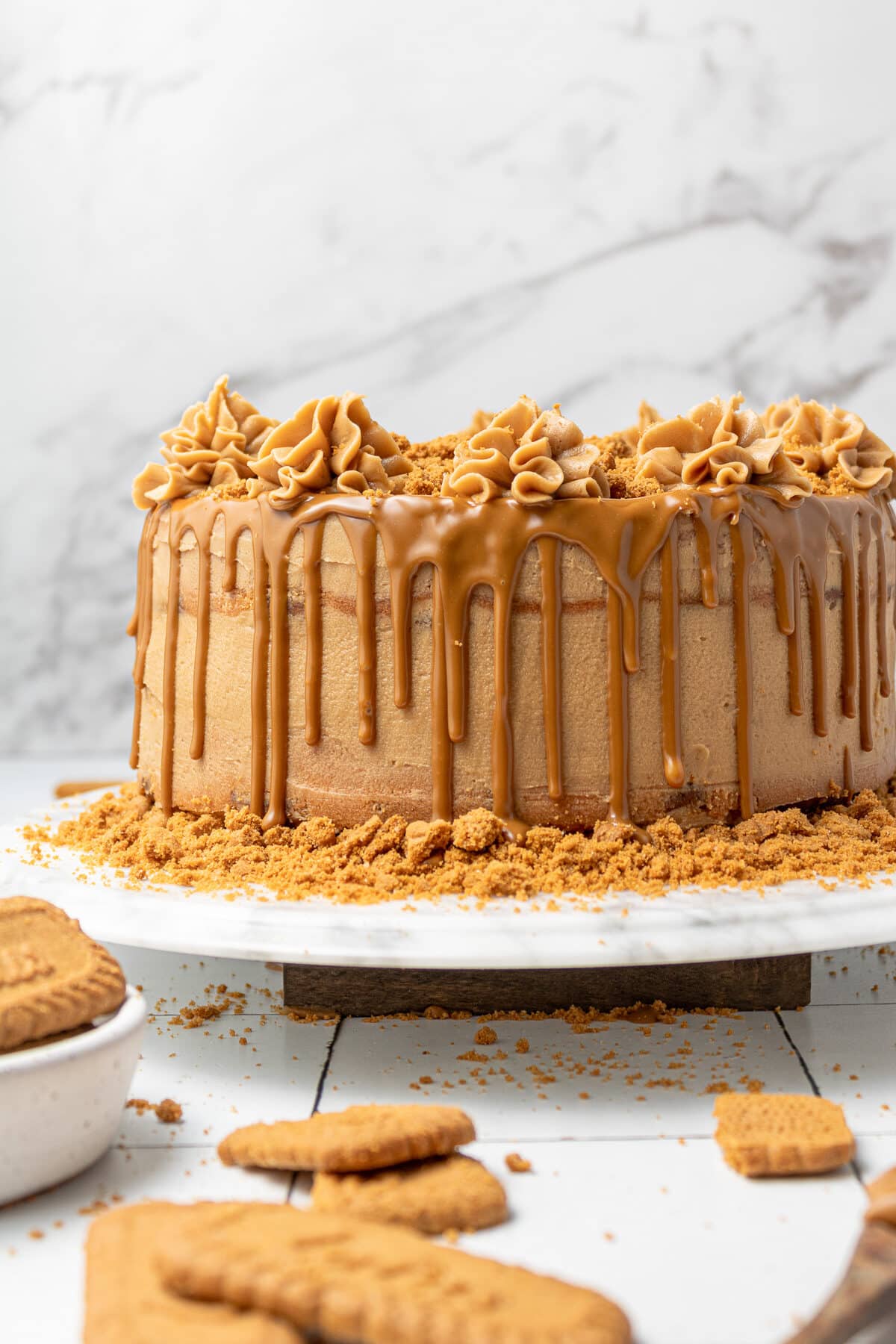
Expert Tips
- As always, my number one tip is to properly measure your flour! The biscoff cake texture will not be as light and fluffy and the cake could turn out dry or dense if you over-measure your flour. I recommend a $10 kitchen scale to weigh your flour.
- Don't skip the parchment paper lining in your cake pans! The cakes could break when you try taking them out of the pan if you skip the parchment paper layer.
- Do not over-mix! This can lead to a dense cake texture. Alternate the milk and dry ingredients and gently mixing until all dry ingredients are just incorporated.
- Adjust powdered sugar (confectioner's sugar) or add milk to achieve the perfect buttercream consistency. If the buttercream seems too thin, you can add a little more powdered sugar, about ¼ cup at a time. If it seems too thick, add ½ tablespoon of milk at a time until your desired consistency is reached.
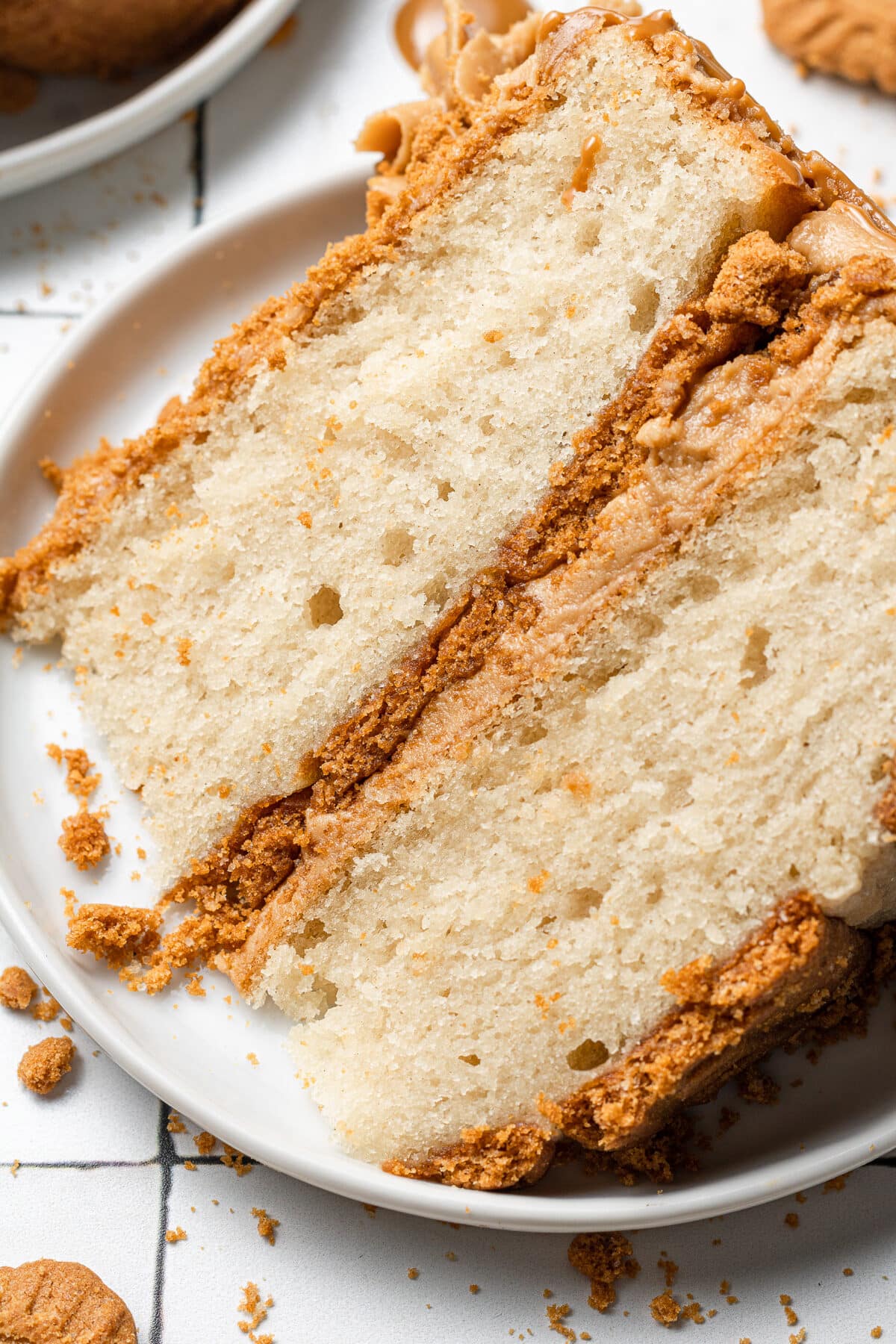
Storage and Freezing Instructions
The cake can be stored covered at room temperature for 3-4 days. I store mine in a cake carrier. The cookie layer will get less crunchy over time, and will soften quite a bit, so the cake is best served within 1-2 days of being baked.
To freeze the cooled cake layers, tightly wrap them in plastic wrap, then aluminium foil. Freeze in ziploc bags for up to 3 months, then let thaw at room temperature.
Leftover buttercream can be stored in an airtight container in the freezer for up to 2 months, then thawed in the fridge. When ready to use it, you can mix it up using a handheld or standing mixer to make it fluffy again.
More Biscoff Recipes You'll Love
If you make this recipe, let me know how it went in the comments below, I’d love to hear from you! You can also tag me on Instagram or Facebook so I can check it out!
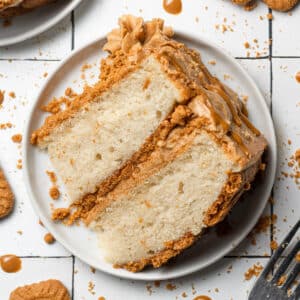
Biscoff Cake
Video
Ingredients
Biscoff Cake
- 2¾ cup all-purpose flour
- 2½ teaspoon baking powder
- ¾ teaspoon salt
- ½ cup butter, softened (regular or vegan)
- ½ cup canola oil (or other neutral oil)
- 1 cup granulated sugar
- 2 eggs
- 2 egg whites
- 1½ tablespoon vanilla extract
- 1¼ cup milk (regular or vegan)
- 22 Biscoff Cookies, plus more for decorating
Biscoff Buttercream
- 1½ cup butter, softened (vegan or regular)
- 1½ cup Lotus Biscoff Spread (or other Speculoos cookie butter spread brand)
- 2½-3 cups powdered sugar (icing/confectioner's sugar)
- ⅛ teaspoon salt
Instructions
Biscoff Cake
- Preheat the oven to 350°F and prepare two 8 inch round cake pans. Spray the inside with cooking spray, then cut round pieces of parchment paper so that they fit in the bottom of each pan (do not skip the parchment paper lining!)
- Whisk flour, salt, and baking powder, together in a medium bowl and set aside.
- In the bowl of a handheld mixer or standing mixer, beat the butter, oil, and sugar until combined. Add in the eggs, egg whites, and vanilla extract.
- Alternate pouring the dry ingredients into the bowl, then pour in the milk. Repeat, mixing between additions and alternating wet and dry until the final specks of flour are gone.
- Layer Biscoff cookies on the bottom of your cake pans, then pour cake batter into the pans, dividing it evenly between the two pans. *Note that in the video for this post I added cookies on top of the batter. You can do this as well, but if you plan to shave off the top domed part of your cakes before stacking them, it's easier to add the cookies to the pan before the batter.*
- Bake on the middle rack of the oven for 23-30 minutes or until a toothpick inserted in the middle of the cakes comes out clean.
- Let the cakes cool in the pans for 20 minutes, then run a butter knife around the outside of the cake to loosen it from the pan and flip upside down onto a cooling rack to cool completely. This helps to flatten the top of the cakes.
Biscoff Buttercream
- Make the buttercream. In the bowl of a standing mixer or handheld mixer, beat butter and biscoff spread together until smooth.
- Add in the vanilla extract, then add the salt and icing sugar, ¼ cup at a time until desired consistency is reached. If the buttercream is too thick, add in milk 1 tablespoon at a time to thin it out to the consistency you want. If it's too thin, add in more confectioner's sugar (powdered sugar) ¼ cup at a time.
Assembling The Cake
- You may want to shave the tops of the cake off to get rid of the domes, but that's optional. Once the cakes have cooled, place one of the cakes on a cake plate or stand, with the biscoff cookie side down.
- Add a few scoops of buttercream on top and spread it in an even layer, leaving around 1 inch of room around the edges. Place the second cake on top, again with the biscoff cookie side down.
- Scoop more buttercream on top of the cake and smooth it out evenly, repeating around the sides of the cake if desired. Melt biscoff and pour it around the edges of the cake, add crushed biscoff cookies on top, and/or pipe more buttercream on top of the cake to decorate the cake to your taste!
Notes
Nutrition
The calorie information provided for this recipe is an estimate. The accuracy of the calories listed is not guaranteed.


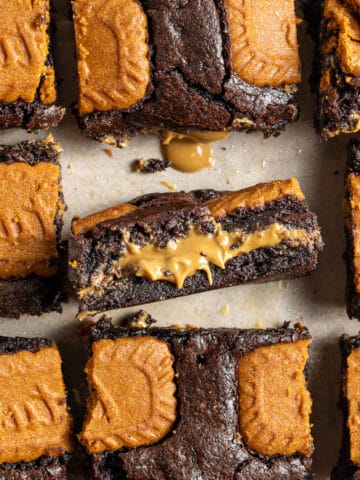
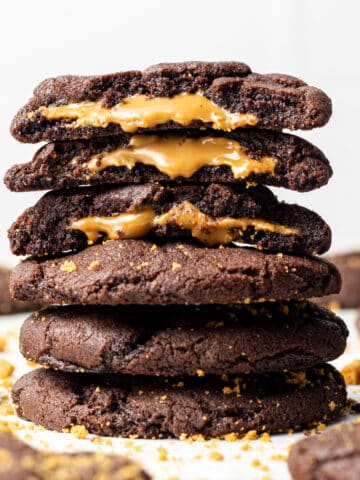
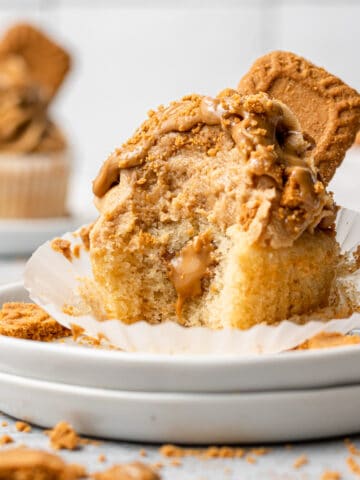
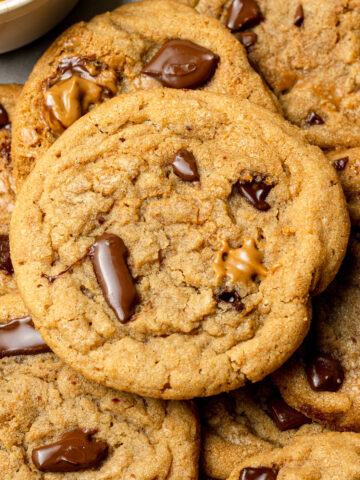
James
You can make this vegan if you leave the eggs out and add a couple of table spoons of cider vinegar or lemon juice to the milk (alternative). This will curdle the milk slightly, creating a vegan buttermilk. Might not look great but works a treat.
Gabby
So glad you had success making it vegan!
Zade
This recipe is incredible! Very easy to follow and extremely tasty. It was a huge hit at our last family gathering.
Gabby
Hi Zade! I'm so happy to hear that you and your family loved the cake! Thanks so much for taking the time to leave a review 🙂
nanc
If I make this cake in a 13x9 pan do I still need to use parchment paper?
Also, do you keep the Biscoff in the refrigerator after it is opened or on the shelf?
Thank you!
Gabby
Hi! It never hurts to line it with parchment paper to avoid sticking, but if you aren't planning on taking the whole cake out of the pan you can also just lightly grease the pan. The instructions should be on the label (they may vary depending on brand), but the ones I've bought have always said to leave at room temperature. Enjoy!
Jenna
I made this cake for my husband's birthday and I did not disappoint! Perfect biscoff flavor, everyone loved it!
Gabby
Hi Jenna! I'm so happy to hear that the cake was a hit! Thanks so much for the review 🙂
Nessa
What's the measurements of the oil, butter and milk in grams?
Gabby
105 grams butter, 120 ml oil, 295 ml milk
Sharon K
Hi Jenna,
This cake sounds yummy. Can't wait to try it. How much vanilla extract goes into the buttercream?
Gabby
Hi Sharon! There's no vanilla extract in the buttercream - it gets tons of flavor from the biscoff spread 🙂 Enjoy!
Lee
delicious, could eat this everyday for dessert. probably breakfast too
Gabby
Hi Lee! I'm so happy to hear that you loved the cake! And I always approve of cake for breakfast 😀